drinking blue-greens |
Diana Lynn Thompson Home Gallery Recent projects 2006-09 2001-05 1994-2000 Exhibition List CV Site Map Contact |
| Copyright Terms: The contents of this web site are protected under Canadian and International copyright law. Please respect this work by not copying or printing it (except for educational and personal reasons ) in any form without express written permission. Just ask and link back! Thanks. |
| cyanobacteria in drinking water insertion/installation art about blue-green algae saltspring island. links for Cyanobacteria in St. Mary lake Cusheon Lake Salt Spring Island BC Canada |
| More information on cyanobacteria and phosphorus: State of Water Quality of St. Mary Lake 1975-1995 St. Mary Lake Water Quality 1979-1981 Working Report Water Quality Assessment of Cusheon Lake Southwest Missouri State University Links to Toxic Algae Cyanobacteria Image Gallery Total Phosphorus and Phosphate Impact on Surface Waters Aquatic pathogens- Cyanophytes Health Canada page on Cyanobacterial Toxins Minimizing your Phosphate use When purchasing laundry, car, boat, dishwashing and other cleaning products, look for “phosphate free” on the label. If the label does not say the product is phosphate-free, it probably contains phosphates. Check the labels on personal products (shampoos, soaps, creams and gels) and try to avoid those containing phosphorus. Under Canadian federal law, all laundry detergents must contain less than 2.2 per cent elemental phosphorus. But you can do even better than that by looking for phosphate-free laundry detergents. To wash your car, use a phosphate-free dish detergent in a bucket of water. Wash your car over gravel or grassy areas, (but not over onsite sewage systems). Dishwasher detergents are a significant source of phosphorus, which are now being regulated in Canada. As of 2010, dishwashing detergents cannot contain more than 0.5 percent phosphorus. Phosphate Free Dishwasher Detergents: Ecover products Seventh Generation Shaklee Powder Sun & Earth Tablet Ivory Purex Merit Selection Nature Clean Phosphate Free Lawn Fertilizers: If you must buy chemical lawn fertilizers, remember that each manufacturer makes several formulas. The only way to be sure your lawn fertilizer has little or no phosphates is to look at the middle number on the label. It should read zero, like this: 2-0-2 . |
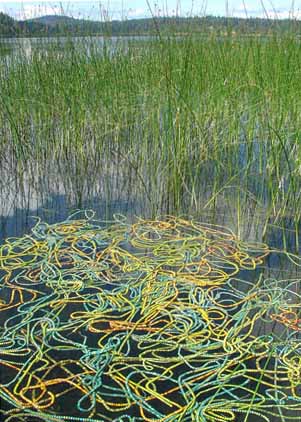 |
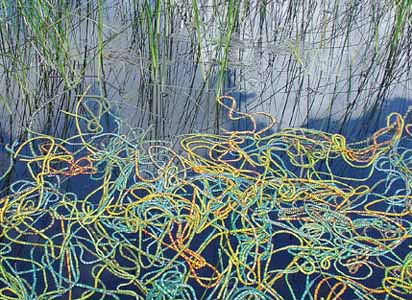 |
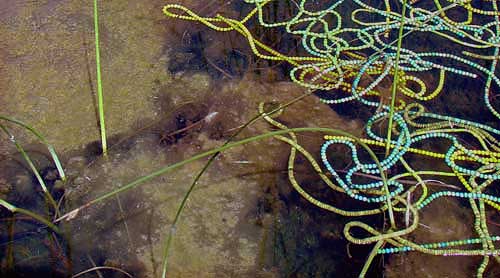 |
| "Drinking blue-greens" temporary insertion/installation August 2007 |
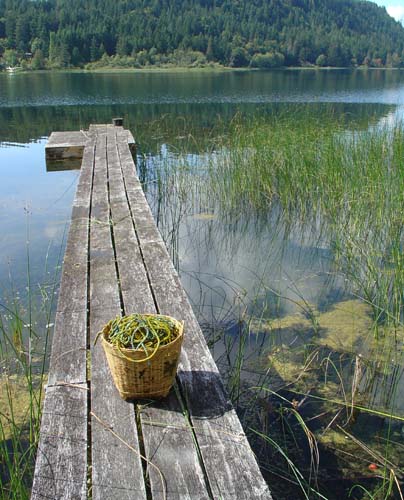 |
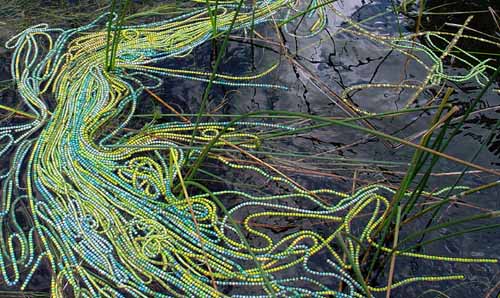 |
| This project was created with the assistance of the BC Arts Council. |
| In 2005, St. Mary Lake, which is a primary source of drinking water on Saltspring Island, had an extraordinary bloom of cyanobacteria (blue-green algae). In 1999, Cusheon Lake on Saltspring also had a cyanobacteria bloom, which caused a two-week ban to be placed on using the water for drinking, cooking or bathing. These algal blooms not only made the water look cloudy, but caused it to have an unpleasant smell and taste. The cyanobacteria also contained toxins that were of considerable concern to the people using the lake's water. The Gulf Islands Driftwood reported in February 2006 that "test results from St. Mary Lake on SSI found algal toxins in numbers that exceeded Health Canada's lifetime-exposure limits by as much as 13 times." It's important to note that this test was from the lake water before treatment. No toxins were found in the (treated) drinking water in an April 22, 2005 test. I have not been able to find out if cyanotoxin tests were done on St. Mary drinking water during the February / March 2005 bloom. Algal blooms such as this are a constant problem in lakes and waterways that are heavily loaded with nutrients. In a presentation given to the public in 2006, Dr. Azit Mazumder stated that a lake from which drinking water is obtained should never be used for recreation. He mentioned septic field drainage, livestock, detergents and fertilizers as possible sources for high amounts of phosphates. Both St. Mary and Cusheon Lakes are surrounded by homes, resorts, small farms and pasture lands. No sewage treatment is available, and residents monitor their own septic tanks and fields. St Mary Lake has the additional problem of a reservoir of phosphorus in the bottom sediment of the lake (this is called "internal loading"). This phosphorus-bearing sediment appears to have been formed in the later 1970s, and is now the major source of phosphorus* in the lake. Increasing the supply of oxygen in the water helps to prevent the release of nutrients from this bottom layer. The North Salt Spring Waterworks District has thoroughly researched the problem and has made the decision to install hypolimnotic aerators on the lake as soon as possible. An experimental aerator installed in 1985 worked to improve water quality and "there were no algal blooms while it operated." ** I remembered from second year biology courses that certain blue-green algae (cyanobacteria) look like strings of beads when seen under a microscope. I decided to use this imagery for a project on the lake. I wanted people to be able to really "see" the algae - not just see murky water. I chose to use wooden beads (so they would float) which I painted with shades of blue and green acrylics. I threaded 120 six- foot lengths of these beads and completed several two and three hour long installations with them at St. Mary Lake. Images of these installations, along with information about the project, were then posted at swimming holes around the Lake and on bulletin boards around the island. This project will be ongoing, as continuing population growth in the area and a warmer climate in the future makes the possibility of further cyanobacteria blooms likely (although the aerators may prevent them). Encouraging the public to reduce their use of phosphates around the lake would be beneficial. (An ounce of prevention... ) There's information about minimizing your use of phosphates at the bottom of this page if you scroll down! * John Sprague PhD information ** Gulf Islands Driftwood article Feb 06, 2006 |
| "Drinking blue-greens" temporary insertion / installation in the shoreline algae at St.Mary Lake 2007 |
| "Drinking blue-greens" temporary insertion/installation August 2007 |
| Links to information, preventative measures and what you can do: Cusheon Lake Stewardship Salt Spring Island Water Preservation Society The Living by Water Project Manitoba Government's Seeing Green site Partnership for Phosphate Reduction CPAWS Wildlife Friendly Waterfront pamphlet |
| "Drinking blue-greens" temporary insertion / installation on St. Mary Lake, Salt Spring Island, B.C. September 2007 |